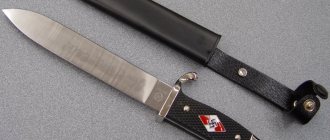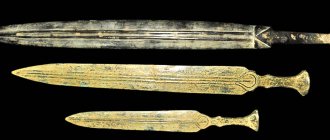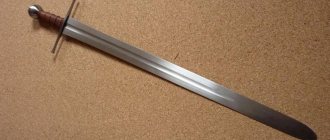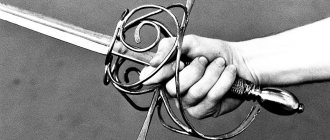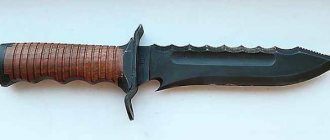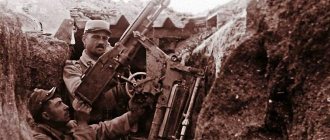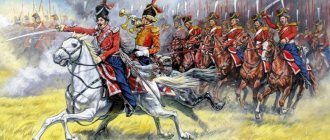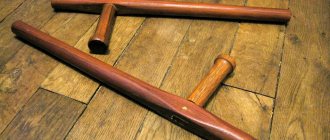Hundreds of thousands of years have passed since the appearance of weapons in human hands. Since the days of the stone tied to a stick, weapons have evolved towards efficiency, convenience and compactness. There have been examples in history of at least exotic weapons. This trend is especially noticeable in Asian countries. Many classes there were simply not allowed to own weapons, but they still needed means of protection. This was the impetus for the development of so many martial arts and the creation of weapons of various shapes and sizes. Many types were prototypes of some household items that a simple peasant could use in times of need.
There were also weapons that were used only by representatives of the privileged classes. One of these weapons is the Qatar.
Decorative finishing of the Cathars
Due to the caste system, in India only a group of military castes and nobility owned weapons, so most Indian weapons are richly decorated with precious metals, bone carvings and decorated with stones. Craftsmen in India knew how to make incisions with gold or silver. They knew the technology of minting and enameling. There was a custom of giving richly decorated weapons to rulers or wealthy landowners.
To decorate the Cathars, the technique most often used was “koftgari” - gold incisions. It was carried out in the following way:
- A pattern of deep scratches was applied with a sharp needle;
- Gold wire is placed in the scratches;
- The wire is driven in with a hammer;
- The surface is heated and hammered in again;
- Polishing is in progress.
Technologies used in decoration
Indian gunsmiths used a variety of materials, including gold and silver incisions, when decorating such types of blades as the Indian Qatar. Edged weapons from all over the world were supplemented by a huge assortment of exotic and deadly knives of different shapes and sizes, which were used in battle as an extension of the hand.
One of the most common finishing methods was traditional Indian gold inlay. The essence of the method was as follows: to make a drawing, a sharply sharpened metal tip was used. Crushed gold (less often silver) was placed into the resulting deep scratches, after which the entire surface was heated and then processed with a hammer. The last step was to sand the surface with a special white porous stone of an abrasive nature.
Fighting technique
The classic katar was used as a left-hand weapon in combination with a saber. At a distance, the Qatari made blocks and parries, and when approaching, they delivered a short fatal blow. The Sikhs used the katar as their main weapon, paired with a small shield. Sikh warriors loved the katar precisely for its ability to kill with one blow. Their code prohibited killing unnecessarily (especially causing suffering to the victim).
In southern India, the katar was used as a weapon for dense bushes and cramped spaces. The katar was worn on the left side of the belt, in front of the saber.
The technique of working with qatar has been preserved to this day in the state of Kerala. It uses piercing blows along various trajectories. When injecting, the blade of the catarrh turns its plane towards the ground. This helps it enter between the ribs, and when it hits the cervical region, it affects many blood arteries. Chopping technique is poorly developed, although many craftsmen use it. The strikes in this case are similar to the “hand-sword” karate technique, and are performed with the body inserted into the strike. There is also a technique of striking on the return of the weapon; double-edged sharpening allows them to be carried out without turning the blade.
The banner of the princely state of Mewar is also decorated with katar, which symbolizes the struggle for independence.
Thanks to the Indians’ love for their traditions, you can find Cathars all over India, and those who want to master the technique of Cathar fighting can learn from local masters who have been passing on their art for many centuries.
Favorite weapon of the upper class Rajputs
Qatar is the weapon of the Indian Rajputs. This is proven by numerous medieval paintings depicting scenes of buffet tables and banquets, where hosts and guests had these unusual weapons in their belts. Rajputs carried blades on the right side. Over the course of many centuries, their shape has undergone very minor changes. That is, the Qatar of the 14th century is not much different from the arsenal made in the 19th century.
It was a fairly effective melee weapon due to its speed and penetrating ability. Despite the fact that it has ceased to be made and used since the 19th century, the image of catarrh can still be found today. The ancient blade is depicted on the official emblem of the modern Rajput regiment - a special unit of the Indian army.
Urumi
If the pata is more interesting for the unique structure of the bowl-handle, then the Indian urumi sword belt stands out among edged weapons due to the incredible flexibility of its blade. Perhaps this is one of the most original sword designs in the history of mankind.
The urumi blade is a flexible, elongated strip of steel, sharpened on both sides. The width of the blade of the belt-sword was about 2-3 centimeters, and the length, judging by some sources, could reach 5-6 meters. Moreover, the owner of this weapon could well have hidden such an impressive blade under ordinary clothes, girding himself with an urumi in the manner of an ordinary belt. For rolling, an ordinary hole was made in the blade of the sword, closer to the tip, which closed on the hilt of the handle.
Warrior with several urumi in his hands
There were many variations of the exotic Indian sword. In addition to varying lengths, which depended on the height and skill of the weapon owner, some examples of urumi were equipped with numerous blades. Several flexible blades on one handle undoubtedly had their reason - multiple cuts when hitting an enemy caused profuse bleeding.
Of course, the sword belt had both its advantages and disadvantages. The undoubted advantage of urumi was the ability to carry it secretly, as well as rapid and unpredictable attacks in the direction. On the other hand, a flexible sword could only inflict cutting wounds on an enemy unprotected by armor, and to accurately destroy the enemy it was necessary to accurately hit vulnerable areas of the body.
Demonstration of the art of mastering urumi
To confidently wield a sword belt required many years of honing his skills: the blades, swift as snakes, did not forgive mistakes and could seriously injure the owner of the weapon.
Pata
The narrow blade, reaching a meter in length, is rigidly fixed in a metal bowl-shell. covering the arm from hand to elbow. Thus, this sword is an extension of the limb, resembling a mechanical prosthesis in appearance.
Pata
Most likely, the design of the pata was a further development of the Indian katar dagger, the blade of which was attached to a frame with two transverse crossbar handles. Perhaps the elongated elbow rests of this blade were modified, received additional protection plates, turning into something like a plate gauntlet.
Pata from the reverse side
However, both types of weapons reached their greatest popularity at approximately the same time, in the 16th-17th centuries, and, most likely, were designed almost simultaneously.
Due to the narrow, elongated blade, the pata looks like a stabbing blade, but this is not the case at all. The rigid design and attachment of the weapon to the elbow joint of the arm completely hampers the movements of the hand, which makes lunging forward very uncomfortable. The double-edged blade of the pata is primarily intended for delivering sweeping slashing blows.
The technique of wielding this weapon was best revealed when using two blades in both hands at once. The warrior, masterfully managing stalemates, turned into a rotating tornado, instantly inflicting numerous cut wounds on the enemy.
Pata 18th century
It is worth noting that in addition to its functional purpose, the protective bowl-mitten of the blade was very often used by gunsmiths as a decorative element and was made in the form of the head of some ferocious animal. This fact undoubtedly gives additional cultural value to outlandish weapons.
Story
The first sources mention this weapon in the 13th century. The earliest images to survive date from the 16th century. The largest number of specimens were found in the 17th – 18th centuries. Historians consider this period to be the peak of his popularity.
First appeared in southern India. Products could also be found in the following countries:
- China;
- Indonesia.
It had an unusual H-shaped handle and a blade located in the area of the finger bones. Its design contributed to its rapid spread in Asian countries. Its functions:
- self-defense;
- emphasizing status;
- hunting.
Has a short wide blade. Two parallel rods form the handle. The length of the blades is 30 – 90 cm. The blade is mostly straight. Less common:
- curved;
- wavy.
Stab knife catarrh.
There are three types of knives:
- single-blade;
- double-bladed;
- three-bladed.
Non-standard cathars
There was a very interesting model of the katar “jamadhar selicani” or katar with three blades. When folded, it is a classic single-edged catarrh. When you press the crossbars, a mechanism is activated that opens the blade like a flower bud. The two halves move in different directions like scissors, and a third blade opens in the middle.
In the literature, an opinion is often expressed that characterizes such a catarrh as a weapon of death, that the blades opened inside the enemy’s body, cutting his internal organs. It is difficult to imagine springs of such force that could force catarrh to open inside the human body. And the blow itself must be delivered along the entire length of the blade, and this will definitely be a mortal wound.
A more plausible version is the theory of using the opening katar to grab and hold the enemy's blade in order to strike him with the main weapon in the right hand. It is unlikely that it would be possible to pull out or break the blade of a saber or sword using such a catarrh, but it is quite possible to hold it for a couple of seconds. In a mortal duel, a couple of seconds can give you the opportunity to deal the fatal blow yourself and emerge victorious from the fight. Numerous finds of three-bladed cathars testify to their popularity (an ineffective weapon simply could not exist for long, since its creator died in the first battles).
In the 15th century, in the south of India, Cathars of a new design appeared - having a special protective shield, like the protection of a rapier. With the Indian love of decorating everything, the shields were often made in the shape of a cobra's head with a swollen hood. They were called no less beautiful than they looked - “bringing death.” Such katars were used in battle as weapons for the main hand. The creation of a protective guard served as an impetus for the evolution of catarrh. As a result, another specific weapon, the “pata,” was invented.
Chakram
An older reader will probably remember the film series of the 90s about the warrior Xena, who willingly used these weapons. There are several variations in the pronunciation of this Indian word. The weapon appeared there, in India. It was used by the Sikhs, a warlike people known for their military prowess.
A metal ring, sharpened to a razor-like state along the outer edge, was untwisted on the index finger and a deadly projectile 30 cm in diameter was sent at the enemy with a movement of the hand. Usually it was thrown slightly upward, and such a simple-looking throwing weapon such as a shuriken or boomerang crashed into the face or shoulders of the enemy, inflicting a mortal wound. It is not known whether it was used in antiquity, but in medieval wars in India, the chakram took many lives from Sikh opponents.
Even in ancient times, warriors came to the conclusion that they needed some kind of short piercing weapon that they could constantly carry with them, and which was convenient for operating in situations where it was impossible to either swing a club or use a spear. The first daggers were made of wood and bone. It is likely that raw animal horns were originally used as daggers.
With the transition to the Metal Age, daggers began to be made from copper. Unlike wooden and bone ones, copper “swords” of the Mycenaean era already had a cutting edge, which somewhat expanded the possibilities of their use. However, they were still very small - with blades only 20-30 cm long - copper was not suitable for making longer weapons.
But even after copper and bronze were replaced by iron, small (with a blade of about 30 cm) “swords” were used by the Assyrians, Greeks and Macedonians.
Types of cathars and their main elements
Kathars were of various shapes, with different blade lengths, and consisted of the following elements:
- The main part of the catarrh was a blade with a length of 10 to 100 centimeters. The shape of the blade of a classic catarrh resembled an isosceles triangle. Sometimes there were blades with a wavy blade that caused non-healing wounds. However, the diamond-shaped cross-section of the blade, combined with the width of the blade, made any deep wound fatal. Sometimes there were cathars with two or three blades; Two iron plates extend from the beginning of the blade, which protect the forearms and wrists. With sufficient skill, they could be used to create blocks to protect against blows from a saber or sword. Naturally, hard parrying is out of the question; this means blocking glancing blows when the guard is placed at a certain angle; At a certain distance from the blade, the protective plates are fastened together by two transverse handles. Sometimes there could be only one cross member, but this did not always provide the required structural rigidity.
With the development of firearms, the Cathars of noble people began to combine them with two pistols. This design was very dangerous for its owner, and the accuracy of the shot left much to be desired.
There are known cases when, before a fight, the catarrh was attached to the arm with ropes or special belts. The catarrh tied to the hand was not lost under any circumstances. Although for the ancient Hindus, tying a weapon to the hand had a slightly different meaning and meant readiness to accept death in battle or fight until complete victory.
There were special military models of the Cathars, which were distinguished by a more diamond-shaped section and blade thickness. They were intended to penetrate enemy armor. In order to strengthen the tip when striking metal, armor-piercing katars had a thickening of the blade near the tip.
As can be seen from the peculiarities of the structure, the catarrh was not intended for delivering cutting blows. Wanting to correct this shortcoming, master gunsmiths created special samples of katars with a curved blade, although these are more civilian versions intended for inflicting non-lethal wounds. The piercing properties were practically lost.
Flying raven and bee swarm
MLRS – multiple launch rocket system. Let's return to the Celestial Empire. Chinese engineers were among the first to conceive of the mass use of medieval MLRS using gunpowder.
Ancient Chinese salvo system
One option was the “Flying Raven” - a cart on which was mounted a square box with many cells, each of which contained an arrow filled with gunpowder. On command, several of these carts opened fire, creating a picture of local hell in the enemy’s ranks, coupled with a great psychological effect. Not all opponents of medieval China were accustomed to deafening explosions. In addition to “raven”, “Swarm of Bees” was also used. This was the name of a smaller box that could be carried by 1-2 people, but it worked on the same principle, mainly by direct fire.
Even in ancient times, warriors came to the conclusion that they needed some kind of short piercing weapon that they could constantly carry with them, and which was convenient for operating in situations where it was impossible to either swing a club or use a spear. The first daggers were made of wood and bone. It is likely that raw animal horns were originally used as daggers.
With the transition to the Metal Age, daggers began to be made from copper. Unlike wooden and bone ones, copper “swords” of the Mycenaean era already had a cutting edge, which somewhat expanded the possibilities of their use. However, they were still very small - with blades only 20-30 cm long - copper was not suitable for making longer weapons.
But even after copper and bronze were replaced by iron, small (with a blade of about 30 cm) “swords” were used by the Assyrians, Greeks and Macedonians.
Etymology:
Arab dagger
خنجر, khanjar
see khanjar;
presumably Turkic. “kanzhal” - 1. sheet of iron (metal) or 2. kan
- blood and
heat
- flog, rip open. intended for throwing.
When writing this article, material was used from the Encyclopedic Dictionary of Brockhaus and Efron (1890-1907).
A blade for the most agile warriors
What is Qatar? The weapon, which required special physical training, quick reaction and dexterity, was intended primarily to hit the head and upper body. Side handles could be used for blocking or, less commonly, for defensive purposes. The owner of such a weapon had to be dexterous and nimble enough to dodge enemy attacks and quickly strike. The big advantage was the light weight and relatively small size.
The Indian Katar dagger was used in close hand-to-hand combat. Indian martial arts in general were characterized by speed, agility and acrobatic maneuvers. Back in the 16th century, at least one fighting style was studied there, which implied the use of a pair of deadly blades: one in each hand. Wielding a katar implies greater acrobatic dexterity than any other melee weapon, such as a knife or standard dagger. Strikes are delivered as if with fists rather than with weapons, which is more natural for defense and attack. If the blade consists of several blades, then with its help you can quite easily catch any more traditional weapon, such as a sword, and move it away from you. In a narrow passage, the owner of the catarrh will have a greater advantage.
Indian blades on the European market
Beginning in the 16th century, after India was colonized by the British, the qatar, a weapon often made from broken sword blades, found its way into the European collector's market. Among them were blades resembling scissors with two or three blades. They were folded together until the handle flaps remained pressed against each other. When pulled apart, the blades open up, causing additional damage to the enemy. These new items were popular among foreigners, but were not practical in real combat.
Design features of Qatar
The first examples of cathars were made in the form of solid structures of the blade and handle. Most likely, such models were military. On civilian examples decorated with gold and designs, a rivet design is usually found. This is understandable, because military models do not need various frills; they are simple and reliable weapons for killing. Civilian models, on the contrary, emphasized the status of the owner more than served as a weapon.
Despite the highest quality of damask steel used for the production of cathars, the blades were additionally strengthened during forging with special stiffening ribs. The grooves on the blades made it possible to reduce the weight of the weapon, expand the blade by saving material, and conduct various hardenings on individual parts of the blade. Beautiful damask patterns on the blade appeared as a result of etching and polishing the surface of the blade.
There were damask blades, on the edge of which tips of another steel were welded. Most likely, this is the result of combat breakdowns and subsequent repairs of the weapon.
Design and varieties
The blade is usually double-edged, straight, wide or narrow, triangular or wedge-shaped, often with a reinforced combat end. Can also be double ( jamadhar dulikaneh
) or triple (
jamadhar sehlikaneh
), arrow-shaped, curved (even flame-shaped).
The length of the blade varies widely, from 8 centimeters to a meter (such katars are already classified as swords. Such katar swords, which had a hilt covering the hand, were called bara jamdadu
or
berajamdeda
, that is, “bringing death”).
The number of blades, as well as their relative position, also varies. The hilt is always metal, of a frame structure (in the shape of the letter “H”), with a transverse handle and side protective shank plates. Some catarrhs have a wavy cutting edge similar to the European flamberge or Malayan kris. There are also katars, the cutting edge of which consists of a set of sharpened semicircular grooves, strikingly reminiscent of the serrated sharpening of modern knives. There is also a mechanical modification: when the handle is compressed, two, or even four, additional side blades are folded out (some European dags had a similar design). There are even katar pistols. [ source not specified 2599 days
]
Melee weapon - Qatar. (109 photos)
| Weapon_room Votes: 1 Blog address: https://www.liveinternet.ru/community/2096528/ Added: 2009-03-19 00:50:25 by blogrider Lurk |
2008-05-09 00:30:20 (read in original)
Article by Dmitry Samoilov “Blade of the God of Death.” After reading this article, you will learn everything (or almost everything) about the Cathars, and also get an idea of what “Wutz” and “Koftgari” are. And of course, you will be able to see the most wonderful Cathars that can only be found on the vast expanses of the Internet.
“Qatar (or jamadhar) refers to push knives, also called thrust knives or knuckle grip knives. The very name of this weapon means “blade of the god of death” or “tongue of the god of death.” They were found in China, Indonesia, and Europe, but were most widespread in India. The heyday of the Qatari “era” occurred in the 16th–18th centuries, although they appeared much earlier. Back in the 14th century. The Arab traveler Ibn Battuta described one of the scenes he saw in India: “The villagers surrounded him, and one of them stabbed him with a catarrh. This is the name of an iron weapon that resembles a plowshare; the hand is inserted into it so that the forearm is protected; the blade is an extension of the arm and is two cubits long (that is, about 900 mm), and a blow with this weapon is fatal.” Qatar was used primarily for stabbing. The blade in the form of an isosceles triangle with a fairly wide base provided a high damaging effect. Such a blade made it possible to inflict severe puncture wounds, which led (at a minimum!) to rapid blood loss; Such wounds did not close on their own, and it was impossible to squeeze them with your hand. Most often, the Kathar blade had the shape of an isosceles triangle, although there are Kathars with other blade shapes and even with several blades. The length of the blade can vary widely from 10 centimeters to a meter or more.
As a rule, the cross-section of the blade is diamond-shaped, characteristic of piercing weapons. Two plates (less often two rods) extend from the base of the blade, running along the forearm. They are either parallel or diverge at a slight angle. At a certain distance from the blade, these plates are connected by two crossbars, which act as a handle. The sidewalls performed several functions. Firstly, they protected the wrist to a certain extent and could be used to parry enemy weapons. Secondly, when combined with a bracer or other protective equipment, they formed a structure similar to a splint applied to a broken hand, thereby further limiting the mobility of the wrist and making the hand-weapon ligament more rigid. The katar is not held by the force of squeezing the fingers, as in the case of a weapon with a traditional handle: the fingers lock the handle in the fist, forming a rigid mechanical structure. The reliability of holding the catarrh will not decrease, even if the hand and handle are wet. Compared to a conventional handle, the depreciation in the wrist joint will be significantly less, which is due to both the limitation of its mobility and the direction in which the load is perceived. The blade is aligned with the forearm, which ensures maximum force input into the stabbing blow. The handle actually rests on the base of the palm. This is especially important when a blow hits a hard target (armor or bone), as it allows you to absorb recoil almost painlessly and absolutely reliably. In the case of a dagger with a regular handle, the counteracting force falls mainly on the rather weak muscles and bones of the fingers. A handle formed by two crossbars is the most common, although on some samples there are handles made from a larger number of crossbars. This design solves one of the main problems that arise when holding push knives, namely: turning the handle in the fist under the influence of force directed to the plane of the blade. In rare examples of catarrh with a handle in the form of a single crossbar, this problem is solved with the help of a large thickening (in the form of a plate) placed in the middle of the handle. In addition, the handle of such structures usually has an oval rather than a circle in cross-section. The specific thickenings in the middle of the handle are reminiscent of traditional Nepalese khukri knives. This thickening serves to prevent longitudinal movement of the hand along the handle. Occasionally there are katars made in the south of India, the handles of which are designed to be wrapped with rope, but most samples do not require such “refinement”. It is known that sometimes before a fight the catarrh was tied to the hand. In the collections of Indian museums there are katars with special straps for fastening to the hand, as well as katars with holes in the handle for passing a rope. Tying served not only as a symbol of fighting to the death or victory, but also as a good method of preventing the loss of weapons in a protracted battle: the reliability of holding a katar tied to the hand is practically independent of the warrior’s degree of fatigue. The possibility of delivering a powerful blow, including against a hard target, determined the fact that many examples of the Cathars were made as weapons for piercing chain mail. Such “armor-piercing” catarrhs have a characteristic thickening of the blade near the tip, which provides additional strengthening of this area, which is most loaded during the injection. As already noted, the design features of the catarrh determine its damaging properties in a piercing blow. However, slashing and slashing attacks are ineffective for them. Some varieties of katar were created with the obvious intention of compensating for this deficiency, such as the katar with a curved blade.
This design, of course, increases the cutting properties of the weapon, but as a result of the tip moving away from the axis of the blade, there is a significant loss of the effectiveness of the piercing blow. Another option involves using a blade with a special cutting edge geometry. Some catarrhs have a wavy cutting edge similar to the European flamberge or Malayan kris. Others have a double-curved blade, their shape reminiscent of a scimitar or the traditional Indian dagger “bichwa”. There are also katars, the cutting edge of which consists of a set of sharpened semicircular grooves, strikingly reminiscent of the serrated sharpening of modern knives.
Of interest is the opening catarrh “jamadhar selicani”, which means “having three blades”. A design feature of this type is a special mechanism that is activated by squeezing the crossbars that form the handle. The mechanism opens the blade into two halves, which diverge at an angle like scissors, which is why in English-language literature this design is called “scissors-katar”. This opens the third blade, for which the hollow halves of the main blade in the folded position act as a sheath. Moreover, this species does not exist in a single copy. The center blade is usually too short to be useful. The halves of the main blade are too thick due to the fact that they must accommodate the central blade when folded. As a result, such a folding catarrh is practically unsuitable for stabbing. There is no clear historical evidence describing the method of use of such catarrh. One of the hypotheses (expressed in both domestic and foreign literature) is that such a catarrh was opened inside the enemy’s body, significantly increasing the damaging effect. It’s hard to believe in this because the effort required to open the catarrh is very significant. It is not difficult to imagine how much it will increase if the catarrh is immersed in the human body. Moreover, the katar mechanism has a return spring that folds the blade halves as soon as the pressure on the handle is removed. Another hypothesis looks more convincing. According to it, the “jamadhar selicani” is an analogue of the European opening dagger “daga springklinge”. Such a dagger is held in the left hand and at the right moment, opening it, turns it into a trap for the enemy’s blade. Of course, we are not talking about breaking the enemy’s blade or snatching the weapon from his hands. Such a trap is intended primarily to delay the return of the enemy's blade, creating a favorable moment for an attack with the main weapon in the right hand. The manuscript of Abul Fazl Allami mentions katars with several points, designed for maximum damage when striking.
A significant number of similar samples presented in various collections suggests that this design was quite common. Another type of catarrh with three blades is described in the literature. This weapon consists of the katar itself and two daggers held in a forward and reverse grip. The main blade has a traditional triangular shape, and the two side blades resemble Indian Bichwa daggers and are directed almost perpendicular to the main one. In 1617 centuries. in Tanjore, Mysore and a number of other districts in southern India, katars with an additional shield to protect the hand gripping the handle became widespread. They are known as "berajamdeda", that is, "bringer of death." The shield often had the shape of a cobra with a swollen hood. Sometimes the shield was covered with openwork holes like the guards of Portuguese rapiers. Typically, such a katar was used as a main weapon in combination with a protective glove or armor covering the arm from hand to elbow; in the left they held a round shield. Many experts are of the opinion that it was precisely these katars with a long blade and developed hand protection that were an intermediate link in the evolution of the katar into the “pata” sword. Many Cathars in the 16th century. were made as monolithic structures in which the blade and handle are one whole. In later designs, the blade was usually attached to the handle using a rivet connection. Special longitudinal ribs give the blade additional rigidity. The grooves on the Katara blade perform a number of functions. Firstly, they make the design lighter, and secondly, the use of grooves (in the case of forging) allows the blacksmith to redistribute the material and make the blade wider at the base, using a small amount of metal for this. Thirdly, thanks to the use of grooves, sections of the blade will have different thicknesses and, therefore, heat up and cool down differently during heat treatment. Ultimately, this will lead to the emergence of a system of multidirectional stresses in different parts of the blade, which helps to increase its strength properties. Indian damask steel (cast Damascus) or wootz was traditionally used to make katar blades. Its carbon content is 1.52%. This material is a metal composite in which “fibers” formed by clusters of very hard spherical grains of iron carbide (cementite) run through a soft iron matrix. Thanks to its unique structure, wootz combines two properties considered opposite in metallurgy, hardness and toughness. Cementite grains emerging on the surface of the cutting edge form a saw at the micro level or, in other words, a kind of microserrator. This ensures the outstanding cutting properties of Wootz blades. The traditional technology for producing wootz was lost in the mid-18th century. Numerous studies have made it possible to restore only the general sequence of actions and explain it from the point of view of modern science. For the first time in Europe, a metal composite, similar in chemical composition and structure to Wutz, was obtained in the 19th century. Russian metallurgist P.P. Anosov, however, the technology he used consisted of alloying iron with graphite and differed from the one described as used by the Indians. It is known that the Indians had several methods for making wootz: both directly from iron ore and from iron. Iron (or two types of iron or iron ore), leaves, glass, charcoal, and possibly a number of other components were placed in a clay vessel (crucible). The vessel was covered with clay mixed with rice husks. Next, it was subjected to heating, which lasted up to several days. During the heating process, the glass melted and formed a flux that binds slag and protects iron from oxidation. When heated, the leaves released hydrogen, which accelerates the process of carburization of iron. A cyclical process was organized in the crucible, during which the iron absorbed carbon, which lowered its melting point and, in turn, allowed it to absorb the next portion of carbon. Thanks to precise timing, Indian craftsmen could stop the process at the moment when small fragments of low-carbon iron floated in the molten iron with a high carbon content. After cooling and breaking the crucible, the master received an ingot of Wutz.
This was followed by the process of forging and heat treating the blade. The final stage was polishing and etching the surface of the blade using a composition of fish bile, palm resin, goat and mare's milk. As a result of the fact that areas with different carbon contents can be polished and etched differently, a pattern of light lines corresponding to cementite fibers appeared on the surface on a dark background. The entire manufacturing sequence from start to finish is full of details, deviation from which will lead to failure of the entire process. First, the components are extremely important: the crucible requires a specific type of clay, the leaves of a specific plant must be used, and the coal must also be obtained from a specific type of wood. It has been established that iron ore must contain vanadium or molybdenum impurities, which serve as the basis for the formation of clusters of cementite particles. Secondly, precise control of the temperature and duration of all stages of the process is necessary. Thirdly, it plays a role in what to cool the blade during hardening, as well as in what area to begin immersing the blade in the cooling composition. There are legends about the phenomenal capabilities of Wutz steel blades, attributing to such blades the ability to cut through armor and the body underneath with one blow, chop stones, cut a silk scarf thrown into the air, bend almost into a ring and then straighten without any harm to oneself. All these amazing characteristics are based on physical phenomena, the study of which has been the subject of many works by Russian and foreign scientists. For example, in the works of V.P. Borzunov and V.A. Shcherbakov gives a very detailed explanation of the nature of the exceptional properties of Wootz. Of course, when talking about wootz, it is necessary to remember that we are talking, first of all, about manufacturing technology, and not about a specific grade of steel with certain standard characteristics. Obviously, wutz smelted by different craftsmen can vary greatly in quality and properties. There are katars made of Wutz alloy, in which the tip is made of another steel and welded onto the main blade. In any case, whether this was done according to the original plan or as a result of repairs, this suggests that the properties of the Wutz steel itself, used to make these cathars, turned out to be inadequate for the task at hand. Many Cathars made in the 16th to 18th centuries use the blades of European swords and rapiers. Such blades in India were called “ferengi” (foreign). For example, the katar in the Tanjore Palace Armory collection has the mark of the famous Italian master of the 16th century on the blade. Andrea Ferara. Another Cathar also has a blade from a European sword. Such Cathars are most common in principalities that conducted active trade with Europe. They bought mainly broken or worn-out swords and rapiers, part of the blade of which was used to make the catarrh. A katar serving as a scabbard for another katar is a rare variety of this type of weapon. In a number of surviving samples, the catarrh sheath is of little use for its intended purpose due to the rounded tip and the absence of blades.
One of the hypotheses for the use of this catarrh is based on the potential for dosing the lethality of exposure. With the help of the sheath catarrh, it was possible to deliver an accented blow that did not lead to a fatal outcome, and in case of escalation of the situation, the sharp inserted catarrh could be removed and used. Sort of like the concept behind Spyderco's Gunting folding knife. Some Cathars 17-18 centuries. decorated with images of tiger hunting scenes. In a number of paintings and illustrations for books of that time, katar is present in the equipment of hunters, and in one it is even used against a tiger (it protects a wounded person who has fallen out of the saddle). All this served as the basis for the erroneous statement that the main purpose of the katar is to deliver the finishing blow to a wounded tiger, although it is obvious that it is much more reasonable for such a purpose to use a spear or other weapon from a safer distance. Despite the implausibility of the hunting hypothesis, in some antiquarian catalogs the catarrh is described as a “dagger for hunting tigers.” A characteristic feature of the Qatar, as well as Indian weapons in general, is the decoration: the higher the status of the owner, the more complex and rich the decoration used by the craftsmen. Indian gunsmiths used various types of finishing, including gold and silver checkering, cloisonné techniques, and embossing. One of the most common finishing techniques used on katars is koftgari: a traditional Indian gold carving technique.
Its essence is as follows: a pattern of deep scratches is applied to the surface using a sharp metal needle. Gold (less often silver) wire is placed and driven into these scratches. After this, the surface is heated and then hammered again. The final stage is polishing the surface with a natural abrasive (white porous Indian stone). Members of the Rajput military class were practically inseparable from the Cathars: in medieval paintings depicting scenes of receptions and feasts, both the host and the guests are shown with Cathars at their belts. Rajputs wore katar on the right side.
It was used in combination with the Talwar saber, and its use was reminiscent of the European technique of working with a dagger for the left hand. When working at a distance, they mainly parried and deflected the enemy’s blade, striking with their saber. As they approached, blocking the enemy’s saber, the katars delivered stabbing blows. In Sikh martial art, the katar is also used as the main weapon for the right hand, while the left may carry a small round shield. The popularity of the Katar among the Nihangs, one of the military sects of the Sikhs, is due to the fact that this weapon allows you to implement the principle of “chatkha”, that is, to kill with one blow. According to the ethical code of the Nihangs, the speed of committing a murder symbolizes a lack of interest in the very process of killing the victim: a Nihang, killing out of necessity (an enemy or an animal), does not commit an atrocity. In the southern regions of India, the katar was considered primarily as a means of self-defense in case of a surprise attack and as a close-combat weapon for rooms and thickets. The katar was worn on the left side of the belt, above the saber. Even a combined double scabbard for carrying a saber and a katar has been preserved. In many paintings, the rulers of Indian states are depicted with their right hand resting on the handle of the katara. This symbolized the readiness to repel any attack. An idea of the technique of using katar can be obtained by watching the performances of masters of the martial art of Kalari Payattu, practiced on the southwestern coast of India (Kerala state). As for the technique of working with katar, most Indian military training systems use predominantly piercing strikes along straight, less often arced, trajectories. For injections in the neck and short side blows to the body, the catarrh is often turned with the plane of the blade parallel to the ground. When hitting the body, this orientation of the blade allows it to pass between the ribs, and when hitting the neck, it increases the likelihood of damaging blood vessels, which, as is known, run vertically. Cutting blows with a katar are delivered with a powerful attachment of the body and are in many ways reminiscent of the “hand-sword” blow in the technique of classical karate. The most characteristic is a chopping blow to the neck area, going diagonally from top to bottom. There is also a special technique for making cuts in a reverse motion after an unsuccessful lunge. Having walked side by side with Indian warriors for several centuries, Qatar has become a unique symbol of military valor.
In the 19th century The Qatari symbol often appeared at the end of the Rajput signature. It was also carved on monuments to those who fell in the name of duty. The symbolism of the Qataris is also reflected in the uniform of the British colonial troops: the emblem of the cavalry regiment of the 13th Rajputs The Shekhawati Regiment is formed by two Qataris crossed over the number 13.
Qatar is depicted on the banner of the Principality of Mewar and symbolizes the armed struggle of Indians for independence. The image of a Cathar is found on silver rupees of the 19th century. and on the first stamps of the Bundi district...” And then those same wonderful Cathars that I wrote about at the very beginning of the post: Here is another “insert” - a Cathar within a Cathar:
Katar "triplex" - consists of two detachable halves, which are connected into one whole and put into a Katar-sheath:
Crooked (well, very crooked) Qatar:
Seven-bladed catarrh, unfortunately there is only one photo and it’s not very clear how to hold this prickly thing or attach something to the elbow??? Maybe someone knows, write in the comments.
Qatar scissors:
> Already familiar to you from the first picture in the paragraph about “Wootz” Qatar in a luxurious damask sheath with a set of tools:
A couple of Kathar pistols:
A long catarrh with a luxurious, simply drop-dead guard, on which fit an elephant, a horse, two peacocks, two antelopes, grass-leaves and something else:
Now let’s move on to cathars with “windows”. What is this you will now see. So, paired catarrhs with windows. In the window of one cathar, apparently, his owner, the rajah, is depicted, in the window of the other - his beloved wife (or concubine):
Since the Cathars will go further with elements of eroticism (what did you think, India! If it weren’t for the Kama Sutra, there wouldn’t be a billion Hindus there now), I categorically do not recommend watching it for people with fragile psyches and children under 18 years of age.
Cathars with “windows”, in “windows”... oh, look for yourself: Well, the very last one, some very sophisticated catarrh in a red velvet scabbard, not only from “Wutz” and with “koftgari” trim, and with “ windows”, and with the Kama Sutra in the “windows”, and for some reason they stuffed shot into his blade... It turned out to be a cool thing, check it out:
Tags : michael_zomer
Unique weapon
From the time man began to hunt animals, he began to develop various types of weapons. Initially, sharpened stones and sticks were used for killing and protection. With the discovery of metal, various types of cold arsenal began to be made: swords, knives, bows and arrows. Weapons such as the katar were not only used for killing and self-defense, but also had great religious and historical significance. The armory was also considered a symbol of status and military dignity among the Rajputs, Sikhs and Mughals. In addition to being used for self-defense, katar was also used to demonstrate wealth and high status.

